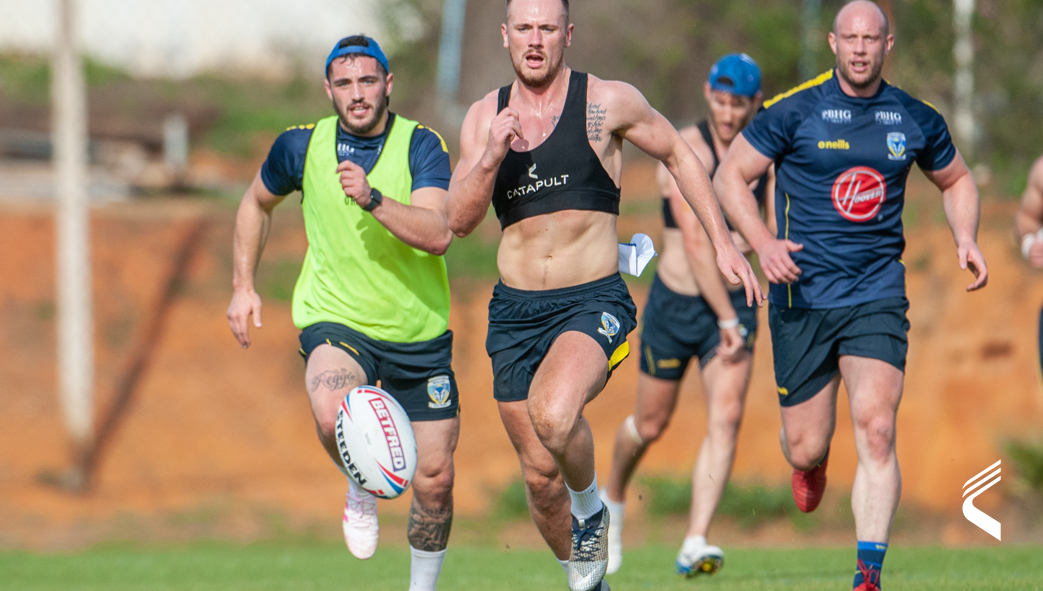3 Ways Catapult is driving innovation in Rugby League
The use of Technology and Data in Rugby League is increasing year-on-year. With the capability to collect physical performance metrics from players, it is taking that understanding of performance data to a whole new level. Wearable technologies, like Catapult Vector, have made it increasingly easy to obtain the athlete-specific data that impacts performance.
Catapult is the league-wide performance partner to all 12 Super League clubs, and this partnership drives foundational and key strategic decision-making around athlete health and performance. Catapult Vector GPS tracking units are worn by the players at all Super League clubs to collect player-specific statistics throughout each game and training session.
As part of our new series of thought leadership webinars, the first episode featured Prof. Ben Jones, who works as Head of Performance for Leeds Rhinos, the Rugby Football League and a Senior Lecturer at Leeds Beckett University.
Throughout this webinar, Jones explained in detail the Catapult’s league-wide deal with the Super League, their involvement in Covid-19 return to-play proximity reports and the rule changes that are made through using Catapult derived performance data.
Watch the webinar below:
—> To learn more about how and why Super League teams use athlete monitoring technology, click here to read our free eBook – The Fundamentals of Athlete Monitoring.
Webinar Insights: 3 Ways Catapult is driving innovation in Rugby League
1.) Covid 19 Proximity Reports
The Covid-19 pandemic had a major impact on the sport of rugby league with competitions suspended for lengthy periods and numerous other competitions canceled or abandoned. Prof. Ben Jones and a team of researchers took up the task of creating a research project to examine the interactions between SARS-CoV-2 positive players and other players during rugby league matches to determine within-match SARS-CoV-2 transmission risk.
“Despite tackle involvements and close proximity interactions with SARS-CoV-2 positive players, in-match SARS-CoV-2 transmission was not confirmed. While larger datasets are needed, these findings suggested rugby presents a lower risk of viral transmission than previously predicted” said Ben Jones.
“The collaboration with Catapult, Leeds Beckett, RFL, the Super League and the support of all the clubs who are really important in this and their support allowed us to maximize the outcomes of the project,” said Jones.

2.) Rule Changes
Due to the global COVID-19 pandemic, the Rugby Football League (RFL) made the decision to reduce the number of close proximity encounters within matches. These included the temporary removal of the scrum and the addition of the ‘6 again’ rule.
The temporary rule changes to rugby league resulted in:
- An increase in whole-match and BIP duration.
- A reduction in average speed and average acceleration.
- No change in peak running demands.
- An increase in the number of carries, tackles, passes and PTBs. during the COVID-19 Pandemic Team Sport Risk Exposure
- Coaches and support staff should be aware that forwards are involved in more tackle events, and therefore may need longer to recover post-match

3.) Fan Engagement
Last year, at the Super League Magic Weekend Catapult delivered real-time player GPS statistics direct to the viewer at home during its live coverage. The link-up with Sky Sports means the data from the GPS devices worn by players at all 12 Super League clubs and collected during the weekend’s six matches at Newcastle’s St James’ Park was sent directly to the broadcaster and delivered in real-time to the viewer.
Catapult stats showed athlete output to the super league fans with insights that focused on three key metrics, distance covered by each player in meters, top speeds achieved, and game intensity measured by how many metres a player runs each minute. Sky Sports Director of Multi-Sports Helen Falkus said “Sky Sports aims to take fans as close to the heart of the action on the pitch as possible, so we’re thrilled that we will be able to share this detailed statistical information with Super League fans tuning in to the Dacia Magic Weekend.”
Elite athletes rely on Catapult’s wearable solution, Vector, for the most accurate and efficient data to empower critical decisions about performance, risk, and return to play.“Where rugby league is set apart from these other field-based sports is that repetitive down, up, sprint back and go again” said Catapult Customer Success Manager Gordon Rennie.
“Interpreting meaningful data from physical output goes beyond just looking at the bare numbers though. Context comes from understanding the effect the attacking and defensive phases of games can have” said Rennie.
–> Click here to learn more about Catapult’s rugby specific-solutions

The Need for Speed: How Measuring Rugby League Players is Revolutionising National Team Selection and Pathway Decisions
The Betfred Super League recently returned to our TV screens, captivating fans with its newfound speed of play, cataclysmic tackles, and line breaks from some of Rugby League’s biggest and fastest players.
We look at the impact of the RFL’s decision to work closely with data, technology, and the media to improve the sport we all love. The speed of the game has increased to better engage fans, national team selection and performance pathway decision-making have improved, and now the game is safer to play for all including amateur athletes. Click here to read more.